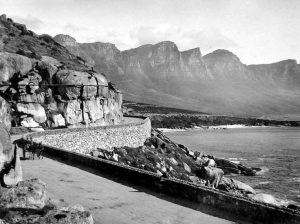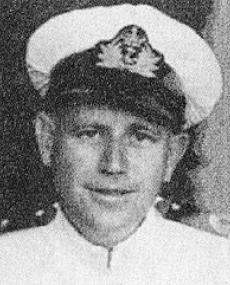 Do you have any missing ancestors in your family tree? Every week, in some town in South Africa, someone is reported missing; but for 99 out of every 100 disappearances there is a simple explanation. Occasionally, however, there is the inexplicable disappearance that remains unsolved, the best-known case perhaps being that of George Arthur Heard, a well-known Johannesburg journalist and political commentator, who was Signals officer with the rank of lieutenant in the South African frigate Good Hope, when he walked off his ship on to the Table Bay Docks on Tuesday, 7 Aug. 1945, and vanished without trace soon afterwards.
Do you have any missing ancestors in your family tree? Every week, in some town in South Africa, someone is reported missing; but for 99 out of every 100 disappearances there is a simple explanation. Occasionally, however, there is the inexplicable disappearance that remains unsolved, the best-known case perhaps being that of George Arthur Heard, a well-known Johannesburg journalist and political commentator, who was Signals officer with the rank of lieutenant in the South African frigate Good Hope, when he walked off his ship on to the Table Bay Docks on Tuesday, 7 Aug. 1945, and vanished without trace soon afterwards.
He was due to report back on board on the Thursday morning; he carried no luggage at all. On the Wednesday morning, he called on his mother-in-law at Sea Point and left there at 2 p.m., promising to return for dinner. He intended, he said, to go back to the ship during the afternoon, but no one saw him there. At about 5.40 p.m. he was observed by a fellow officer, Lt. C. A. Perkins, strolling along the Main Road, Sea Point, as though on the way to the bus terminus. So far as is known, no one saw him again. Two days after he was due back on duty, a message was broadcast instructing him to return to his ship. When this brought no response, the police and Press were informed. A week later a reward of £100, soon increased to £250, was offered for information leading to his discovery:
 On 22 January 1947 Mrs. Heard, who had two young sons, applied to the Supreme Court to presume her husband’s death. In an affidavit, she stated that a diver had suggested that, on returning to the Good Hope, Heard might have tripped over a mooring, fallen into the sea and been held at the bottom by the weight of his greatcoat; but no body was found. An insurance company refused to pay out on a life policy, and the court held that Heard was not proved dead. A second application to presume death, made on 11 December 1952, was granted, but the mystery remains unsolved. One of the most likely theories was that he deviated to the rocks on the sea front at Sea Point and fell so heavily that he lost consciousness and was swept out to sea.
On 22 January 1947 Mrs. Heard, who had two young sons, applied to the Supreme Court to presume her husband’s death. In an affidavit, she stated that a diver had suggested that, on returning to the Good Hope, Heard might have tripped over a mooring, fallen into the sea and been held at the bottom by the weight of his greatcoat; but no body was found. An insurance company refused to pay out on a life policy, and the court held that Heard was not proved dead. A second application to presume death, made on 11 December 1952, was granted, but the mystery remains unsolved. One of the most likely theories was that he deviated to the rocks on the sea front at Sea Point and fell so heavily that he lost consciousness and was swept out to sea.
One of the most prolonged searches began on 4 June 1949 in Cape Town. On that day Isaac Lang, aged 71, left his home in Upper Mill Street to walk to his son’s home in near-by Vredehoek, but did not arrive. One of his sons, N. V. Lang, set out to find his father, who was believed to be suffering from loss of memory, and had more than 2,000 circulars printed with full particulars. These were distributed throughout the Cape and to police stations and motor associations in all four provinces. He organised and led search parties, tramped the back streets of the city for weeks, and followed up flimsy clues in the country districts -all to no avail. Ruling out murder or suicide, the fact remains that nobody resulting from death by misadventure was ever found.
`That leaves us’, stated the son, `with the supposition that he was alive for some time after 4 June. How then was he, an old man with hardly any memory, able to support himself? The most acceptable solution appears to be that he was befriended by some poor White or Coloured people who, with the kindness of the poor, looked after him as a member of the family. After a while he would become known as “Piet van der Merwe” or “John Smith” and, under an assumed name and with his own identity erased from his mind, he would one day have been presented to a magistrate with a request for an old-age pension. This would be readily granted and the proceeds should have been quite sufficient to reimburse his hosts for his keep.’
On 11th November 1982 Johannes Hendrik de Bruyn, builder and preacher of the Apostolic Faith Mission, left his home in Rivonia, Johannesburg. Next day his car was found abandoned near a sewage farm at Illovo, another Johannesburg suburb. A week later Pastor De Bruyn’s wife received an anonymous telephone call from someone who told her she would never see her husband again, that he was dead and buried. As in other instances of disappearance, he was reported to have been seen at various, widely separated places, such as South-West Africa and the Orange Free State, in some cases with a female companion described as a `red-headed woman’ and under another name. There can be little doubt, however, that he met his death, probably by violence, soon after he left his car.
In 1964 the C.I.D. in Cape Town were faced with a mystery that was to prove even more baffling than the disappearance of Isaac Lang. The question that required an answer was: Would a man of 56, in good health and with no apparent domestic problems or ties, living in luxury and ease in a bungalow on the Peninsula sea front and with assets of 1300,000, have suddenly decided to take his life or abandon everything for a precarious existence in a foreign land?
Norman Stanley Rose vanished on the afternoon of 18 June 1964, when he and a friend were walking from Lion’s Head to Clifton. They had driven as far as the Malay tomb on the Lion’s Rump and then took different routes that would lead them back to the car. Rose was never seen again. Five days later his dog arrived at a cottage not far from his bungalow. If it had been guarding its master’s body day and night, why had this not been found?
Experienced mountaineers had scoured every yard of every possible area where Rose might have fallen to his death. If his body lay exposed, they would surely have found it. Frogmen and divers searched the coastline on the assumption that a murderer might have taken the body out to sea and thrown it overboard. They drew a blank. Another theory, far-fetched but just feasible, was that Rose’s body was buried in the soft ground beside Victoria Road, between Bakoven and Hout Bay.
Contractors had blasted and bulldozed hundreds of thousands of cubic yards of earth and rock from the mountainside and heaped it in embankments below the road. To remove the rubble in a search for a body would have been impracticable. Dead he almost certainly is, though by 1970 the courts had not yet presumed him legally so. Meanwhile, his sister offered a reward of R5,000 to the `first person giving satisfactory information leading to his whereabouts’. The body of Norman Stanley Rose was discovered on the lower slopes of Lions Head in June 1975, positively identified through dental records. A fire had cleared a section of the mountain above Nettleton Road and a bird watcher stumbled upon the remains in what had previously been thick bush. The cause of death was never established.
I would love to hear about your missing ancestors.





